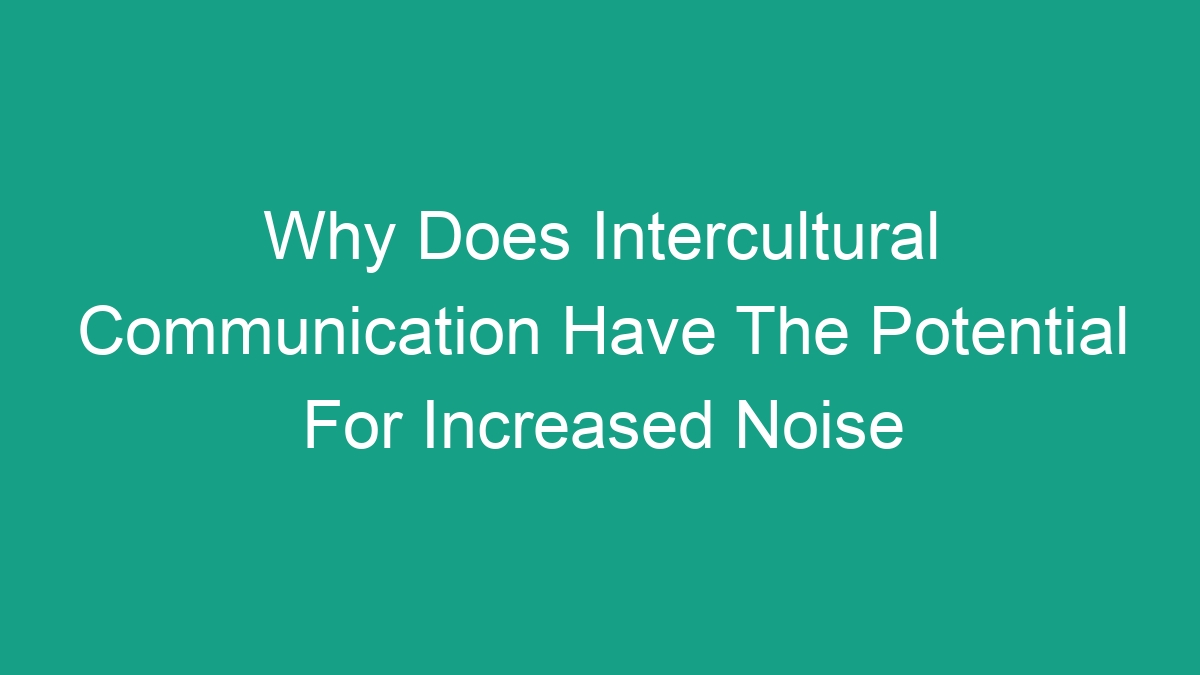
In today’s interconnected global society, intercultural communication has become increasingly important. As people from different cultural backgrounds interact and collaborate, the potential for increased noise in communication also grows. This article will explore the reasons why intercultural communication has the potential for increased noise and provide insights into how to navigate this challenge effectively.
The Role of Cultural Differences
One of the primary reasons why intercultural communication can lead to increased noise is the presence of cultural differences. Culture encompasses a wide range of elements, including language, customs, values, and norms. When individuals from different cultural backgrounds communicate, these differences can lead to misunderstandings, misinterpretations, and confusion.
Cultural differences in communication styles can manifest in various ways. For example, some cultures prioritize direct and explicit communication, while others value indirect and implicit communication. In a business context, this can lead to confusion and frustration if one party perceives the other as being too blunt or too vague. Additionally, cultural variations in nonverbal communication, such as gestures, facial expressions, and body language, can contribute to noise in intercultural interactions.
Moreover, cultural differences in linguistic patterns can also give rise to communication noise. Language is deeply intertwined with culture, and different linguistic structures and idiomatic expressions can lead to misunderstandings. Idioms, metaphors, and humor that are easily understood in one culture may not translate effectively into another, leading to potential communication breakdowns.
Issues of Stereotyping and Prejudice
Stereotyping and prejudice can significantly impact intercultural communication and contribute to increased noise. When individuals hold preconceived notions about other cultures, they may be more inclined to misinterpret and misjudge the intentions and meanings behind communication.
Stereotypes can affect both the sender and the receiver of the message, leading to biased interpretations and misunderstandings. For example, if one party holds stereotypes about the work ethic of a certain culture, they may interpret the actions and behaviors of individuals from that culture through a biased lens. This can lead to miscommunication and the perpetuation of negative stereotypes.
Moreover, prejudice can influence how individuals perceive and respond to intercultural communication. If someone holds prejudiced views about a particular culture, they may be more likely to dismiss or devalue the perspectives and contributions of individuals from that culture, leading to a breakdown in communication and increased noise.
Complexities of Intercultural Communication
Intercultural communication is inherently complex, and this complexity can give rise to increased noise in various ways. This complexity stems from a multitude of factors, including linguistic diversity, historical context, power dynamics, and identity politics.
Linguistic diversity poses a significant challenge in intercultural communication. In a global context, individuals may be communicating in a second or third language, leading to potential language barriers and misunderstandings. Moreover, the presence of multiple languages within a single cultural group adds another layer of complexity to communication.
Historical context also plays a crucial role in intercultural communication. Many cultural interactions are shaped by historical events and power dynamics, which can manifest in subtle ways within communication. Awareness of historical context is essential for understanding the underlying dynamics that can contribute to increased noise in intercultural interactions.
Furthermore, power dynamics within intercultural communication can lead to imbalances that contribute to increased noise. The unequal distribution of power and influence between different cultural groups can impact how communication is conducted and understood. It’s important to recognize and address these dynamics to mitigate the potential for noise in intercultural communication.
Strategies for Mitigating Noise in Intercultural Communication
While intercultural communication may have the potential for increased noise, there are strategies that individuals and organizations can employ to mitigate these challenges. These strategies involve developing cultural competence, promoting active listening, and fostering open-mindedness and empathy.
Cultural competence is essential for navigating the complexities of intercultural communication. This involves developing an understanding of different cultural worldviews, communication styles, and values. By building cultural competence, individuals can navigate intercultural interactions with greater sensitivity and awareness, reducing the potential for noise in communication.
Active listening is another critical skill for effective intercultural communication. By actively listening to the perspectives and concerns of individuals from different cultural backgrounds, individuals can gain a deeper understanding of their communication preferences and styles. This can help reduce misunderstandings and contribute to more effective communication.
Additionally, fostering open-mindedness and empathy is crucial for navigating intercultural communication. By approaching communication with a willingness to understand and empathize with others’ perspectives, individuals can minimize the potential for noise and build more meaningful and respectful relationships across cultural boundaries.
Conclusion
Intercultural communication has the potential for increased noise due to cultural differences, issues of stereotyping and prejudice, and the complexities inherent in cross-cultural interactions. However, by developing cultural competence, promoting active listening, and fostering open-mindedness and empathy, individuals and organizations can navigate these challenges effectively and engage in more meaningful and productive intercultural communication. As our world becomes increasingly interconnected, the ability to communicate across cultural boundaries with clarity and sensitivity is more important than ever. It is essential that we recognize and address the potential for increased noise in intercultural communication and work towards building stronger connections and understanding across diverse cultural contexts.



